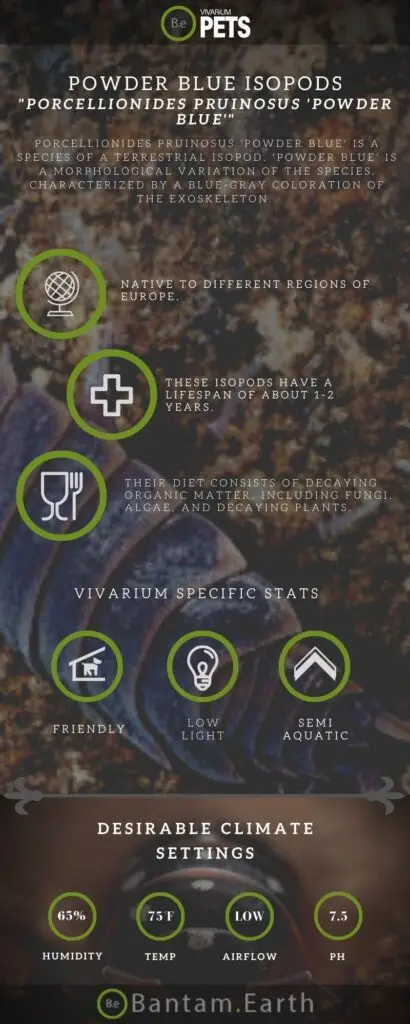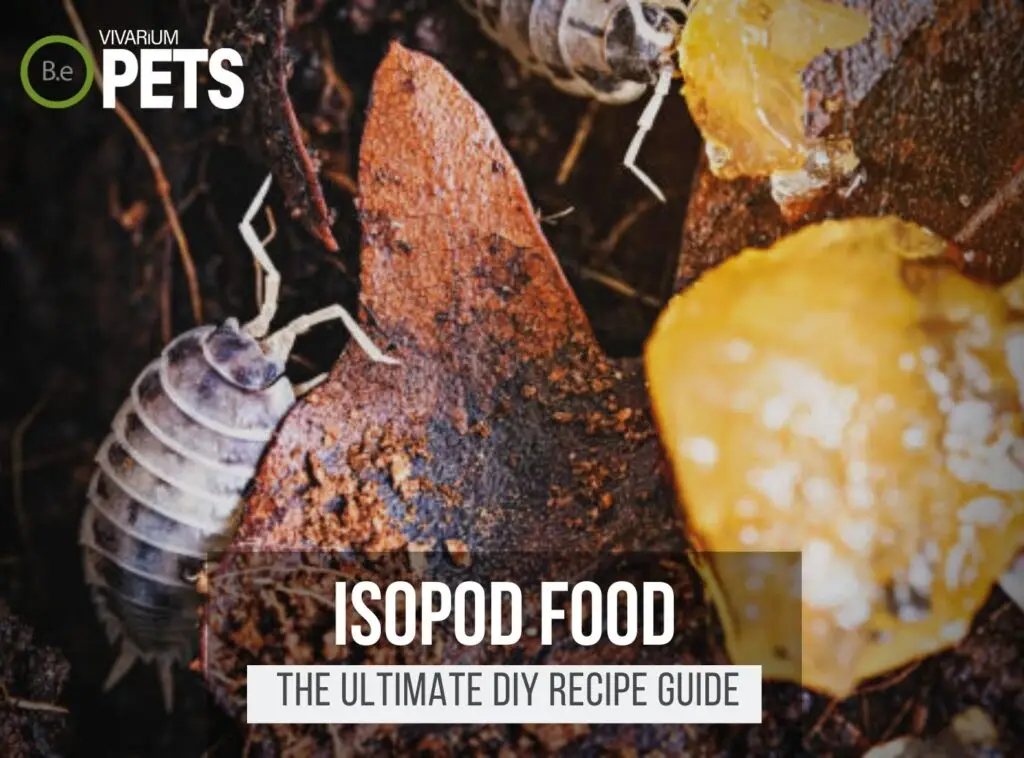Welcome to the world of Powder Blue Isopods! Porcellionides pruinosus ‘Powder Blue’ are small crustaceans that make fascinating and rewarding pets.
If you’re looking for an unusual Porcellio species to keep as a pet, then you may want to consider adding some of these powdered baby critters.
In this guide, you’ll learn about the supplies and setup you need, as well as ideal temperatures and humidity levels, recommended diets, and tips for successful breeding. Ready to dive in?
Let’s take a closer look at powder blue isopods and find out what they need to thrive!
Table Of Contents:
ToggleWhat Are Powder Blue Isopods?
Powder Blue Isopods are a blue mutation of the popular powder orange isopod species.
The name Powder Blue Isopods comes from the blueish-gray powdered coloration of the carapace, which is often flecked with white and brown spots.
They are members of the family Porcellionidae. They are relatively small, reaching up to just a few centimeters in length.
Create an ideal habitat for your Powder Blue Isopods with our Customizable Isopod Terrarium Kits, which include everything you need to get started.
What Do Powder Blue Isopods Look Like?
Porcellionides pruinosus ‘Powder Blue’ range in size from just a few millimeters in length to up to half an inch.
The body of the Powder Blue Isopod is broadly oval, covered with light brown or grayish mottling and light-colored spots.
The underside, legs, and antennae of the Powder Blue Isopod are a bright powder blue color, giving them their name.
They also have a pair of antennules in front of the antennae and two cerci at the back of the body.
Benefits Of Using Powder Blue Isopods
Porcellionides pruinosus ‘Powder Blue’ is widely used in vivariums. These isopods are desirable for their low-maintenance care and their useful effect on the enclosure’s ecology.
Powder Blue Isopods are natural scavengers, consuming detritus, other microorganisms, and decaying plant matter which helps to keep your tank clean.
These isopods also act as food for larger animals in your bioactive terrarium, providing essential nutrition.
These isopods do not require any supplemental light, as they are non-photosynthetic, so they are relatively affordable as well.


Powder Blue Isopod Facts
Powder Blue Isopods have an average lifespan of one to two years, are detritivorous by nature, and have a shy yet gentle temperament.
They are relatively easy to breed, with female adults producing between 30-50 eggs per mating.
Habitat
Porcellionides pruinosus ‘Powder Blue’ is a small species of woodlice native to Europe as well as Southwest Asia.
They have since been spread around the world through the ornamental trade. The natural habitat of Powder Blue Isopods is woodlands, meadows, and agricultural land.
In their natural habitat, they live in leaf litter and on the tops of rocks and other soil structures.
They can also be found in the bark of tree trunks and damp places with lots of organic matter, such as in rotting logs and compost piles.
Powder Blue Isopods are not very tolerant of changes to their environment and prefer dark, humid areas with a lot of organic debris.
Replicate their natural habitat perfectly with our Bioactive Isopod Substrate Blend, designed to provide the ideal moisture and organic content for your isopods.
Diet
Powder Blue Isopods are omnivorous and can eat a variety of plant and animal matter.
In their natural environment, they feed on decaying plant matter, such as dead leaves and flowers, as well as small decaying insects, and other invertebrates.
Powder Blue Isopods will supplement their diet with fungi, lichens, and small amounts of wood. They also scavenge for food on other animals, such as millipedes, earthworms, and slugs.
Temperament
Porcellionides pruinosus ‘Powder Blue’ is known to be quite calm and non-aggressive towards humans and other animals.
Powder Blue Isopods usually try to avoid contact with humans, as they are timid creatures, so they can be a great choice for pet owners looking for a species that is not inclined to bite them.
Although they don’t need a lot of direct interaction from their owners, they can provide a unique insight into the natural world and offer a calming presence in the home.
Lifespan
The Powder Blue Isopod will live a relatively short lifespan of a year in captivity. Their life cycle begins with mating.
Female Powder Blue Isopods will lay eggs soon after copulation – usually between 8-14 days.
Depending on the temperature and humidity, the nymphs will mature into adults around 3-6 months after hatching from the Eggs.
Once the Powder Blue Isopods reach adulthood, they will continue to reproduce. Generally speaking, however, their life expectancy does not increase drastically.
Breeding
Powder Blue Isopods mate and reproduce similarly to other species of isopod.
For courtship and mating, male Powder Blue Isopods must first locate and attract a female.
Once the male has attracted a female, they will perform a ritualized courtship dance involving the circling and tapping of the appendages.
After mating, the female Powder Blue Isopod will produce up to 50 eggs at a time, which are stored in a rudimentary brood pouch underneath her body.
These eggs hatch within a week to 10 days, and the juvenile offspring remain in the brood pouch until they are large enough to survive outside of it.
As the juveniles mature and reach sexual maturity, they can begin breeding with other members of their species and the cycle continues.
Where To Find Powder Blue Isopods
Finding Powder Blue Isopods in the wild can be a challenging task as they are quite small in size and quite rare to spot.
They are mostly found in damp, shaded areas and prefer to inhabit moist leaf litter and logs in various habitats ranging from grasslands to forest floors.
Therefore, a walk in a local park or woodland area is a good place to start and higher success rates can be found in more secluded areas, far from human contact.
For those not interested in the wild hunt, these small isopods can also be found in hobbyist stores or breeder sites.
Always check the health of the isopods you purchase as it is important for them to be active and healthy before being introduced into the tank.
Powder Blue Isopod Care
To care for Powder Blue Isopods one should provide them with a substrate-focused tank, and accessories, and maintain the right temperature and humidity levels.
Their diet should include a variety of vegetable matter. Breeding can be encouraged by ensuring the right temperature, humidity, and sufficient food.
Care tips include providing hiding spots and strategic lighting.
Tank Requirements
The ideal tank requirements for Powder Blue Isopods are a vivarium type such as a paludarium or terrarium; a neutral pH of between 6 and 8; a hardness of between 4 and 8 dH;
I recommend a temperature of between 64 and 80°F and a terrarium substrate of organic matter such as coconut husk, peat moss, and fir bark.
Furthermore, low to medium terrarium lighting with a timer will help regulate an artificial day/night schedule.
This setup allows for the Powder Blue Isopods to avoid light stress and their tank to remain moist enough for their physiological needs.
Additionally, the presence of organic matter in the substrate also allows them to seek food, as they are scavengers.
What Do Powder Blue Isopods Eat?
Powder Blue Isopods will eat a variety of plants and insects, making for a very diversified diet. Some of the items you can feed them include:
- Fruits and vegetables, such as apples, carrots, cucumbers, lettuce, zucchini, and other leafy greens.
- Protein sources, such as crickets, mealworms, and other small bugs.
- Flower petals, such as hibiscus and sunflower.
- Mushrooms, such as dried porcini mushrooms.
- Shredded coconut and small pieces of cooked grains like quinoa or millet.
- Calcium supplements, such as powdered cuttlebone, crushed eggshells, or reptile calcium powder.
If you’re more of an avid hobbyist like myself, be sure to check out my ultimate DIY Isopod food guide. I give a more in-depth explanation of the best foods and my favorite recipe.
Best Tankmates For Powder Blue Isopods
When selecting tankmates for this species, it is important to choose ones that can live in the same conditions.
Powder Blue Isopods do well with other peaceful, small invertebrates, such as snails, springtails, and other isopods.
They require a lot of hiding places and leaf litter, so it is important to provide these for your tankmates as well.
Other fish and animals, such as catfish, plecos, clownfish, tetras, and guppies, make good tankmates for Powder Blues because they can live in the same temperature range.
Conclusion
In conclusion, Powder Blue Isopods (Porcellionides pruinosus ‘Powder Blue’) are a fascinating and unique species of pet to keep, requiring proper temperature and humidity levels, the right tank and substrate setup, and a tailored diet.
With the proper care and attention, these isopods can be successfully bred and reared and can provide hours of entertainment and enlightenment.
Create the ideal habitat for your isopods with our species-specific soil mixes and Insect Enclosure Kits. These products provide everything you need for a successful and thriving isopod colony.
Frequently Asked Questions
Yes, powder blue isopods are a popular species of isopod that make for interesting and fun pets. However, they can also be great food, live food, and cleanup crew in terrariums and vivariums. They are easy to care for and can provide a variety of benefits to tanks.
Powder blue isopods (Porcellionides pruinosus ‘Powder Blue‘) are a type of small terrestrial crustacean found throughout Europe, which appear bright blue when fresh and powder blue as they age. They are popular as pets and thrive in terrariums.
No, Powder Blue Isopods (Porcellionides pruinosus ‘Powder Blue‘) do not bite.
Porcellionides pruinosus, also known as the ‘Powder Blue’ isopod, has natural predators including birds, reptiles, insects, and amphibians. While they are not particularly vulnerable to predation, they may still be targeted by these predators in the wild.
Porcellionides pruinosus, or ‘Powder Blue’ isopods, typically grow to a length of around 6 mm. However, the size may vary slightly depending on the individual isopod’s age, sex, and environmental conditions.








